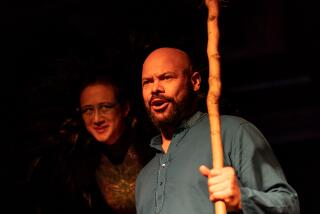BOOK REVIEW : Shakespeare Aids in Defense of Chimps : VISIONS OF CALIBAN: Of Chimpanzees, People and the Honored Shape by Dale Peterson and Jane Goodall ; Houghton Mifflin; $22.95, 367 pages
- Share via
While Prospero, in “The Tempest,” is made to denounce Caliban as a “freckled whelp, hagborn,” he also allows that the “man-monster” is, at least, “honored with (a) human shape.”
The same could be said, Dale Peterson and Jane Goodall suggest in these pages, of the great ape: a being human in appearance, yet wrongly regarded as savage and brutish. What both “The Tempest” and our treatment of the ape tell us, Peterson writes, is that our confidence in man’s moral primacy may be misplaced.
“Shakespeare imagined with astonishing brilliance and foresight how people might behave toward a being they considered to be neither quite beast nor quite human,” writes Peterson. “Caliban, though possessing the honored shape, nonetheless endures as an abused and despised lost sibling of human kind, huddled beyond the edge of humanity’s moral island.”
“Visions of Caliban” is a rich and many-pleasured book: it’s a trek through the African bush, an authoritative work of natural history, and an urgent manifesto of environmental activism. Peterson and Goodall want us to know that the chimpanzee, so funny and so familiar, is actually an abused and endangered species. Above all, they encourage us to look on the chimpanzee as something more nearly human than we have allowed ourselves to believe.
Peterson and Goodall seek to amaze us with the unsuspected strengths and proclivities of the chimpanzee. A 135-pound female chimp scored a 1,260-pound pull in a laboratory test while a football player in peak condition was able to pull only 375 pounds--and the athlete used both hands.
Another chimp was credited with sacrificing his own life to protect a human companion from an attack by a swarm of bees. And Peterson introduces us to one female chimp who discovered how to use a vacuum cleaner as a sexual plaything.
Still more amazing--and, according to the authors, more significant--are the gifts that we associate only with human beings. As we learn in “Visions of Caliban,” chimpanzees are able to fashion and use tools to gather food. They appear to know how to diagnose and medicate themselves with natural remedies. And they have been taught to “speak” in sign language.
“Visions of Caliban” is much concerned with the use and abuse of chimpanzees for medical research and crash testing, as objects of entertainment, as exotic household pets, and even as “bush meat” for human consumption. At times, the book turns into a work of investigative reporting as Peterson probes the international black market in chimps for biomedical experimentation and the controversy over the alleged mistreatment of orangutans in a Las Vegas floor show.
Peterson uses the allusions to Caliban and “The Tempest” as a kind of moral and literary touchstone throughout the book. Of course, the Shakespearean motif is something of a literary gimmick, and sometimes it just doesn’t work. Peterson is stretching, for example, when he invokes the Bard to make a point about the disappearance of the natural habitat of the chimpanzee.
“When Shakespeare wrote ‘The Tempest,’ forests covered 10 million square miles of land in the tropics,” he writes. “Today we are left with fewer than 4 million square miles, roughly a fifth of which are found in Africa.”
Another literary gimmick is the use of a dual narrative--one written by Peterson and set in Roman type; the other by Goodall and set in italics. The effect is conversational and mostly agreeable, but Peterson is the more extravagant and thus the more entertaining of the two writers. “Certainly this book is more Dale’s than mine,” the famous primatologist concedes.
At one point, Peterson warns us against “exaggerated anthropomorphism” when gazing upon chimps who have been dressed up in human clothing and thrust in front of a camera.
And yet “Visions of Caliban” seems to argue that we are more intimately related to our fellow anthropoids than we suspect. Goodall sums it up when she describes how Louis Leakey responded to her earliest discoveries of the tool-making and tool-using abilities of chimpanzees in the wild.
“Ah!” said the famous paleontologist. “Now we must redefine Man, redefine Tool or accept chimpanzees as humans.”
More to Read
Sign up for our Book Club newsletter
Get the latest news, events and more from the Los Angeles Times Book Club, and help us get L.A. reading and talking.
You may occasionally receive promotional content from the Los Angeles Times.







